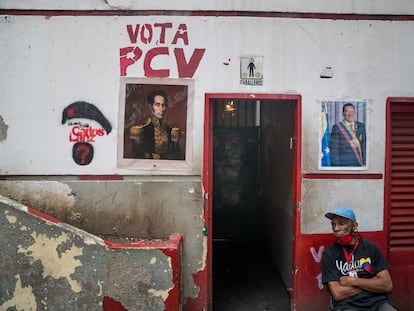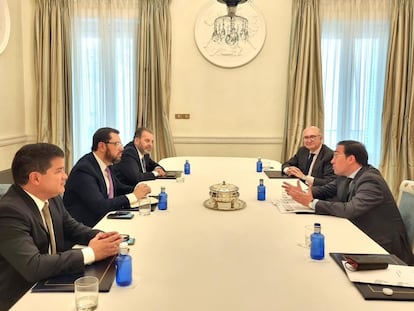Quality of Venezuelan gas raises alarm as cars catch fire amid widespread shortages
The corruption scandal engulfing state-owned energy company PDVSA has been exacerbated by huge lines at filling stations and vehicles breaking down due to fuel impurities

A TikTok user recently uploaded a video in which he uses a gas pump at a filling station as a drum kit. The joke has garnered thousands of likes but it has become a topic of serious conversation in recent days in Venezuela. Over the last few months, the problems being caused by the poor quality of the fuel produced by the state-owned energy company PDVSA have worsened. Videos of cars on fire and interviews with mechanics talking about an epidemic of broken gas pumps have proliferated while PDVSA is mired in a corruption scandal, leading the government of Nicolás Maduro to carry out a purge of high-ranking company officials.
The Minister of Petroleum and Maduro protege Tareck El Aissami was forced to resign and according to the latest report from Attorney General Tarek William Saab, a vast anti-corruption operation launched by Venezuelan authorities has seized more than a thousand assets, including mansions, yachts, airplanes and luxury vehicles, while 80 PDVSA officials have been arrested in 172 raids.
In the western oil-producing state of Zulia at least 26 vehicles have caught fire so far this year, according to the emergency services, including one belonging to the international NGO Caritas, which distributes humanitarian aid. Cases have also been reported in the east of the country and in Caracas. Meanwhile, fuel shortages are once again causing lines stretching for miles at filling stations. There are also concerns that the gasoline being distributed is dirty, that the octane rating is not correct, or that it contains too much sulfur.
In an attempt to quell growing fears over the quality of gas, PDVSA released a video in which officials are seen giving citizens in the city of Maracaibo a sniff of fuel extracted from a tanker truck into a plastic bottle. The campaign has been incendiary and has unleashed a raft of memes and jokes about “gasoline sommeliers.” The oil company also stated on its official television channel that the issue of burning cars is due to either to leaks in their tanks, the use of defective spare parts or incorrect handling when refueling.
🇻🇪🗞️ #Entérate || Comunidad verifica estado del Combustible recién llegando a la Estación de Servicio Santa Fe en el Estado Zulia.#PDVSA#ElCombustibleQueNosMueve@NicolasMaduro@TellecheaRuiz pic.twitter.com/0v6yo92Dkx
— Petróleos de Venezuela, S.A. (@PDVSA) April 26, 2023
Oswaldo Rivas has been a mechanic for 20 years and has been amazed by the condition of the pistons in the vehicles being brought to his shop. “Gasoline is causing a lot of piston-knocking and that eventually damages the engine,” says Rivas, who specializes in European cars. “There are bad fuel pumps everywhere. They burn out, you change them, then they get damaged again and it’s difficult to start the cars first thing in the morning. You change the fuel filters and after a month they are the same again: water and mud come out of them.”
Failing fuel tank gauges, which show either more or less gas than the tank contains, are also a common source of conversation. The sale of additives and different types of fuel, and even gallons of imported fuel such as ethanol to increase the octane level, has become widespread at gas stations. Oswaldo, for example, adds one designed for racing cars to his own vehicle: “I prefer to spend money on that and take care of my engine.”
In Venezuela, gasoline is part of everyday life in a way that other countries can scarcely imagine: at one time, it was distributed as a gift or paid for with candy because there was no currency. It has been taboo to increase the price of gas after the social protests of 1989. For several decades, Venezuelans paid the equivalent of a few U.S. cents per liter at subsidized gas stations, which have been gradually disappearing. Today, filling up at a dollarized station can cost $20 and customers spend hours in line to do so — and then drive away under the fear their vehicle will be the next one to catch fire. In some states, fuel rationing and distribution schedules according to license plate numbers have been put in place.
The current shortages are the culmination of a lengthy crisis at PDVSA caused by years of mismanagement and corruption, which have brought the once exemplary state-owned entity to its knees. Venezuela’s oil industry has also been hampered by U.S. sanctions, which have been making the country’s commercialization of crude oil difficult since 2019. The Maduro administration has turned to Iran for help to alleviate the crisis. Between 2020 and 2021, Iranian fuel ships and technicians arrived to repair refineries and increase oil production, which had fallen to historic lows. However, the industry is still struggling to match its historic production levels and it has taken almost two years to engineer an increase from just under 400,000 to 700,000 barrels per day, the amount Venezuela currently produces.
“The gasoline we are producing is out of specification,” says Iván Freites, general secretary of the union of professionals and technicians of the Federation of Petroleum Workers, who went into exile two years ago when he was persecuted for publicly denouncing the industry’s shortcomings. “The gasoline being produced in the catalytic plant does not exceed an octane level of 82 and has a high sulfur content. The soda it drags in during catalysis and the high volatility causes pressure in the combustion system and causes it to ignite. Hence the damage to pumps and vehicle fires,” he says.
Furthermore, Freites says, naphtha and olefins are being added instead of the extra components that should be in the formula. “The poor quality of gasoline is also due to poor operating standards and the use of unqualified personnel.” Freites also states that the sediments accumulated in the storage tanks, after inventories are depleted, are being removed and integrated to the gasoline that is distributed.
The union leader estimates that Venezuela currently produces around 80,000 barrels of gasoline per day, although domestic demand exceeds 110,000 barrels. Even though the oil industry has been reduced to 20% of the capacity it had a decade ago, discount supply agreements with allies of Caracas are still in place and a large part of the country’s fuel production is supplied to Cuba while, according to Freites, still providing the smuggling mafias with means to run their operations.
As such, Cuba is also experiencing huge shortages that forced President Miguel Díaz-Canel to cancel the country’s Workers’ Day parade on Monday. The Cuban president said a few days ago that the country is only receiving two-thirds of the fuel it requires from Venezuela, pointing to the problems being experienced by Caracas as the reason the Maduro government cannot “meet its commitment” to keep the island stocked up.
Sign up for our weekly newsletter to get more English-language news coverage from EL PAÍS USA Edition
Tu suscripción se está usando en otro dispositivo
¿Quieres añadir otro usuario a tu suscripción?
Si continúas leyendo en este dispositivo, no se podrá leer en el otro.
FlechaTu suscripción se está usando en otro dispositivo y solo puedes acceder a EL PAÍS desde un dispositivo a la vez.
Si quieres compartir tu cuenta, cambia tu suscripción a la modalidad Premium, así podrás añadir otro usuario. Cada uno accederá con su propia cuenta de email, lo que os permitirá personalizar vuestra experiencia en EL PAÍS.
¿Tienes una suscripción de empresa? Accede aquí para contratar más cuentas.
En el caso de no saber quién está usando tu cuenta, te recomendamos cambiar tu contraseña aquí.
Si decides continuar compartiendo tu cuenta, este mensaje se mostrará en tu dispositivo y en el de la otra persona que está usando tu cuenta de forma indefinida, afectando a tu experiencia de lectura. Puedes consultar aquí los términos y condiciones de la suscripción digital.
More information
Archived In
Últimas noticias
There is as much life left to discover on planet Earth as that which is already known
Dozens presumed dead, around 100 injured in fire at Swiss Alps bar during New Year’s celebration
Is porn for women different from conventional porn? We spoke to those who make it
Cartagena de Indias is sinking: What can the city do to mitigate it?
Most viewed
- Sinaloa Cartel war is taking its toll on Los Chapitos
- Reinhard Genzel, Nobel laureate in physics: ‘One-minute videos will never give you the truth’
- Oona Chaplin: ‘I told James Cameron that I was living in a treehouse and starting a permaculture project with a friend’
- David King, chemist: ‘There are scientists studying how to cool the planet; nobody should stop these experiments from happening’
- Why the price of coffee has skyrocketed: from Brazilian plantations to specialty coffee houses










































